38 Snakes in Missouri (5 are Venomous!)
#mobileSnakeQuizControls { overflow: hidden; text-overflow: ellipsis; white-space: nowrap; }
@media (min-width: 481px) {
.mobile-top-content {
display: none;
}
}
#mobileTopContentCTACarouselControls { overflow: hidden; text-overflow: ellipsis; white-space: nowrap; }
.mobile-top-content .more { color: #fff; }
.mobile-top-content a { color: #fff; text-decoration: underline; }
.mobile-top-content a:hover { color: #fff; text-decoration: underline; }
@media (max-width: 480px) {
.mobile-top-content {
background-color: #06a10b;
color: #fff;
text-align: center;
/*height: 60px;
padding-top:5px;*/
font-size:80%;
/* display: block; */
margin: 0px -30px;
}
}
Missouri is known for having wide open plains, expansive waterways, and a large section of the Mississippi River. It also is home to almost 40 different species of snakes. That’s a lot of snakes, but only five of those snakes are venomous. The other types of snakes will usually not bother you as long as you don’t bother them. However, it’s never a good idea to taunt, harass, or try to handle a snake in the wild. Even non-venomous snakes can strike or bite if they are annoyed or if they feel threatened. Let’s dive into the snakes in Missouri so you can better understand the snakes of the “Show-Me” State.
Common Snakes In Missouri
The type of snakes that you run into in Missouri will depend largely on where in the state you are. There are distinct geographical areas of the state that each have different types of snakes. For example, snakes that live across almost the entire state of Missouri include the:
- Western Wormsnake
- Yellow-Bellied Racer
- Ring-Necked Snake
- Eatern Hognose Snake
- Prairie Kingsanke
- Speckled Kingsnake
- Milksnake
- Norther Water Snake
- Western Ratsnake
- Midland Brownsnake
- Ribbon Snake
- Eastern Gartersnake
- Smooth Earthsnake
- Copperhead (Venomous)
- Timer Rattlesnake (Venomous)
All other snakes in the state have more limited geographic presences that might not be in the Ozarks, long the Mississippi, or lacking from the prairies across the state. Now that we’ve established some of the most common snakes that range across almost all of Missouri, let’s dive into some nonvenomous snakes you’ll find in the state.
button.pulse {
transform: scale(1); animation: pulse 2s infinite;
box-shadow: 0 0 0 0 rgba(11, 247, 25, 1);
}
@keyframes pulse {
0% { transform: scale(0.90); box-shadow: 0 0 0 0 rgba(11, 247, 25, 0.5); }
60% { transform: scale(1); box-shadow: 0 0 0 15px rgba(11, 247, 25, 0); }
100% { transform: scale(0.90); box-shadow: 0 0 0 0 rgba(11, 247, 25, 0); }
}
Diamondback Water Snake
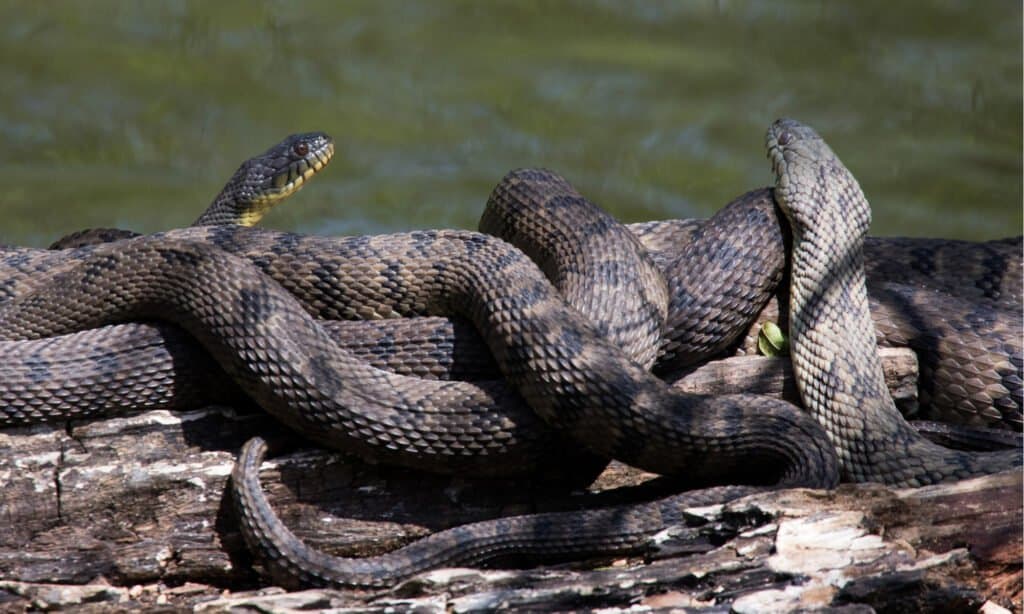
Laurie L. Snidow/Shutterstock.com
The diamondback water snake lives mostly near the rivers and lakes that dot the entire state of Missouri. If you fish or boat or spend a lot of time on the Mississippi River you will almost certainly see a diamondback water snake at some point. These snakes are not large, but the coloring patterns may mimic the color patterns of a venomous cottonmouth snake. Don’t approach a diamondback water snake unless you’re certain it’s not a cottonmouth. Diamondback water snakes don’t attack humans, but they may secrete a terrible odor trying to scare you away. They also might play dead if you startle them. Diamondback water snakes can grow up to four feet in length and aren’t found in the Ozarks.
Plains Garter Snake
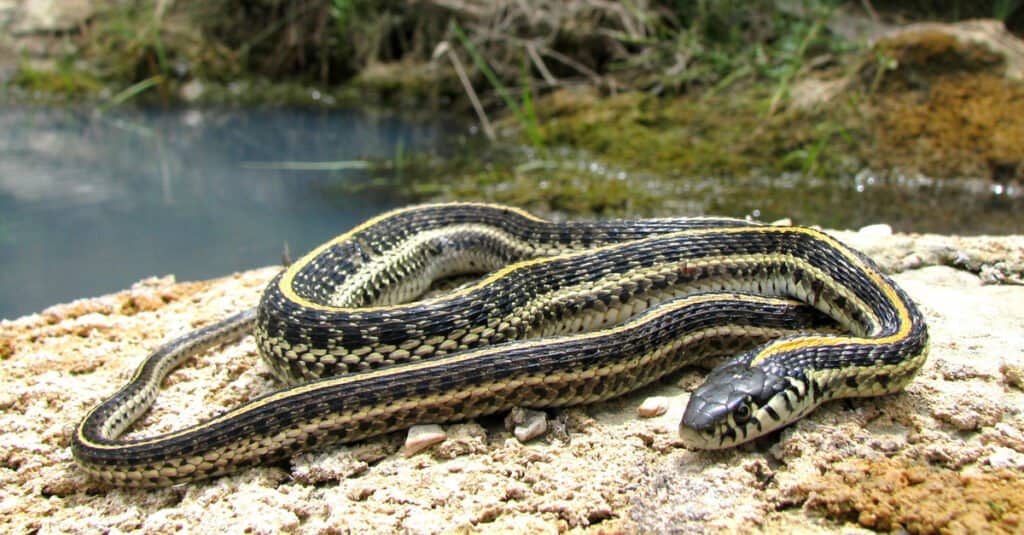
Joe Farah/Shutterstock.com
The plains garter snake is a very colorful snake and you should be able to see it easily even in the tall grass. These snakes have a dull gray-green primary body color but they also have vivid stripes of yellow, or orange that run the entire length of their bodies. The natural habitat of the plains garter snake is prairies and meadows which means that Missouri is a perfect place for these snakes to live. If you are horseback riding, hiking, or biking across the prairies keep an eye out for a flash of yellow or orange as a Plains Garter snake goes by. The snakes are found most often in the northwestern corner of the state, but are also common in the greater St. Louis region.
Bull Snake
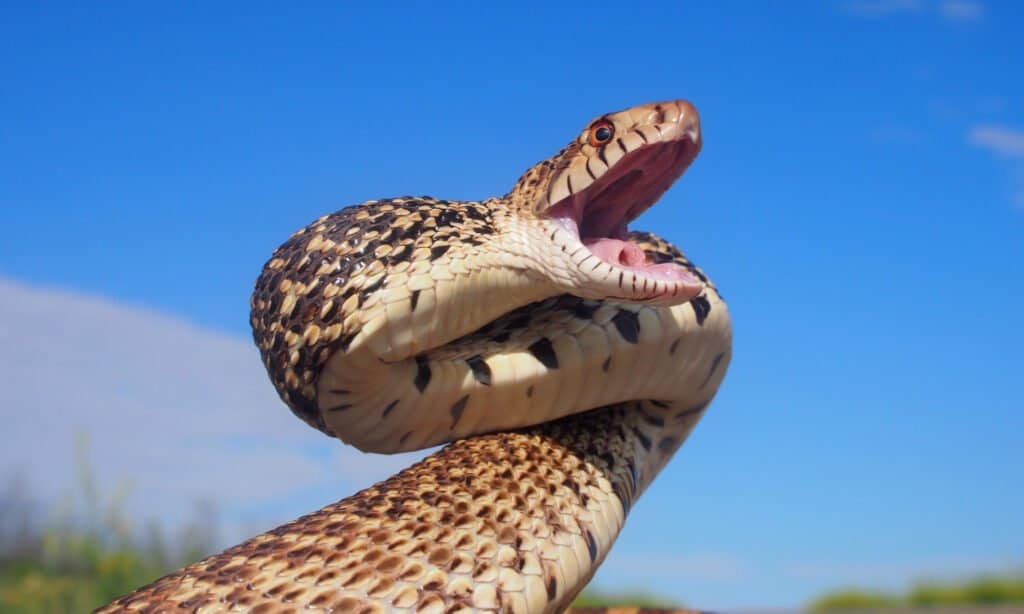
Markparker1983/Shutterstock.com
Bull snakes (gopher snakes) are some of the largest snakes in the entire U.S. and are often around six feet in length. They constrict their prey so they have wide heavy bodies that can crush mice, rats, and other rodents. They also eat birds, because bull snakes can slither their way up trees and into branches. Make sure that you keep an eye out for snakes above you in the trees when you’re enjoying outdoor activities in Missouri. Bull snakes are not venomous, but they are strong and powerful and have even been known to eat venomous rattlesnakes. It’s best if you don’t approach bull snakes even though they aren’t venomous. Bull snakes are common across Missouri grasslands ut are less common in the Ozarks and the southern portion of the state.
Eastern Coachwhip Snake
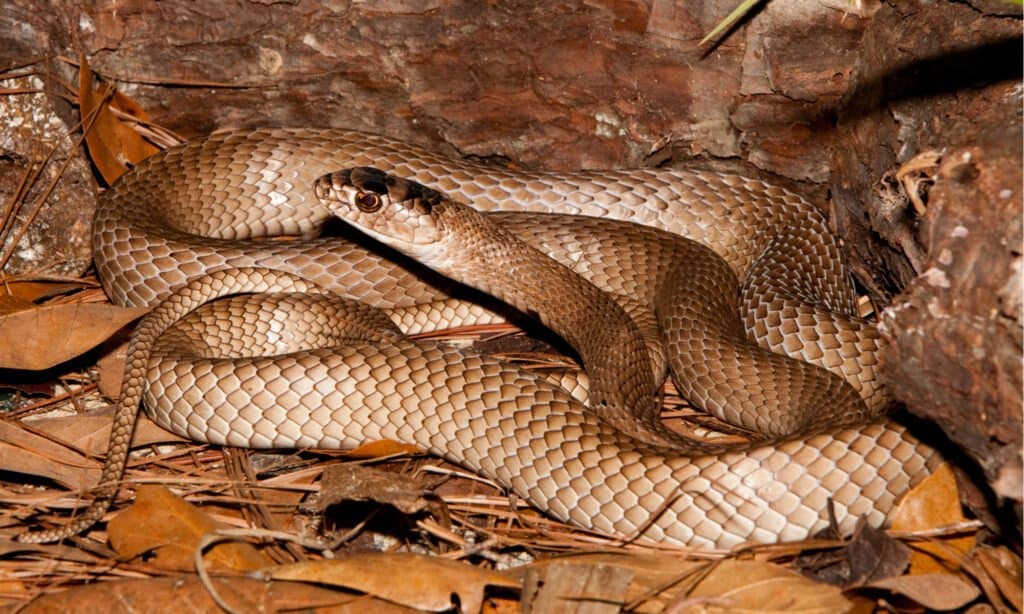
Jay Ondreicka/Shutterstock.com
Eastern coachwhip snakes can look very scary but they are actually non-venomous and won’t hurt you unless you are antagonizing it. They are usually black or very dark brown to blend in with their surroundings and they can be extremely long. They are also very fast. Most of the time by the time you realize that there’s a snake near you it’s gone if it’s an eastern coachwhip! Sometimes these snakes will vibrate their tails to make a sound that is similar to a rattle trying to scare away something that they think is a threat.
Coachwhips are found across most of the southern half of the state, but are absent from the southeastern portion of Missouri.
Western Mud Snake
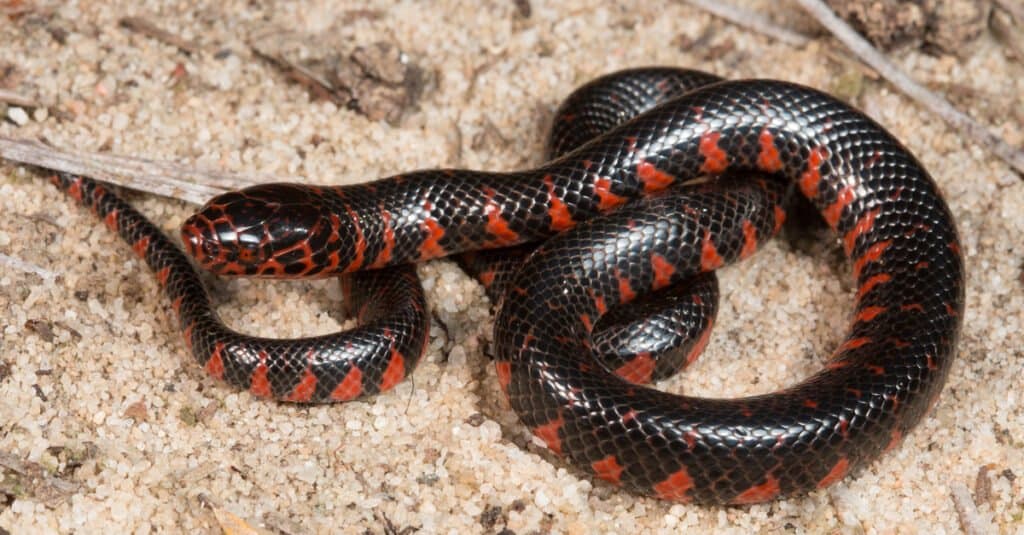
Nathan A Shepard/Shutterstock.com
We just described how coachwhips are absent from the southeastern corner of Missouri, so let’s introduce a snake species that’s only found in the southeastern portion of the state.
Western mud snakes are nocturnal so most of the time you won’t see them. Because they prefer to be active after dark these snakes have evolved a pitch-black body color but they have a bright orange or red set of markings that you should be able to see even at night. If you’re hunting early in the morning, or setting off for a hike soon after sunrise you may see some western mud snakes that are getting ready to go underground for the rest of the day.
Venomous Snakes In Missouri
There are three types of rattlesnakes in Missouri, in addition to a couple other venomous snakes. Even though Missouri doesn’t have a lot of venomous snake breeds there are enough that anyone who is spending a lot of time outdoors should know how to identify these venomous snakes and always be careful whenever you come across snakes in the wild so that you can avoid a potentially very serious bite:
Eastern Copperhead

iStock.com/David Kenny
The eastern copperhead has slightly less potent venom than other snakes on this list so chances are pretty good that if you get bitten by a copperhead you won’t become dangerously sick. However, you still need to get medical attention right away if you are ever bitten by a copperhead. These snakes have a very distinctive copper tan color on their heads and pinkish-red coloring on their bellies. That should make it a little easier to identify them. They are relatively small and max out at about three feet long. The average length for a Copperhead is just over two feet.
The snakes are found across nearly all of Missouri with just a small part of the state being outside their range along the Iowa border.
Cottonmouth
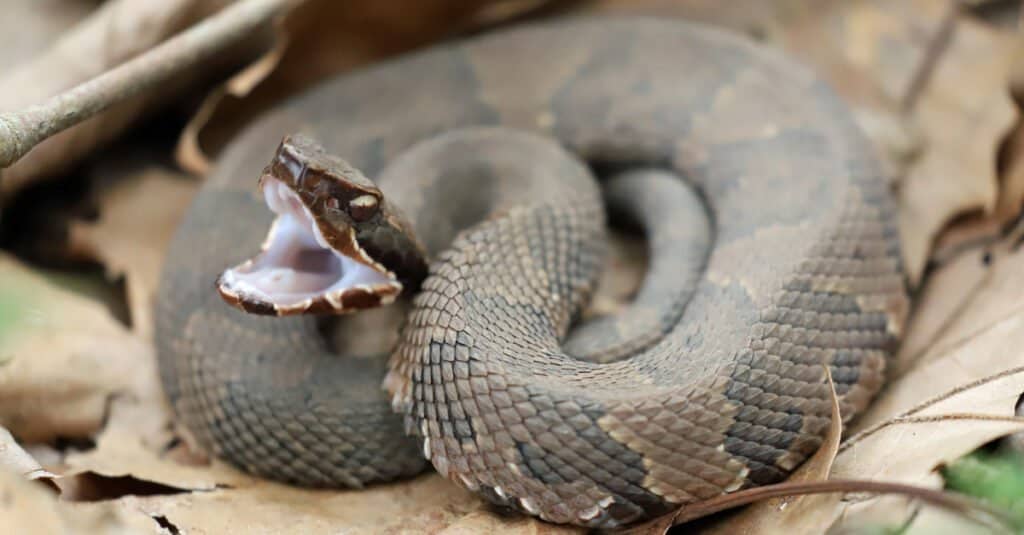
KF2017/Shutterstock.com
A cottonmouth snake can have several different color variations that may be confusing because they make it look like other breeds of snakes. However, the cottonmouth has one distinctive feature that you will only ever see on a cottonmouth and that is a white mouth.
When the Cottonmouth raises its head you will see white around the mouth and there will be two black bars underneath its mouth. If it opens its mouth you will see that the inside of the mouth area is also white. But if a cottonmouth is opening its mouth at you then you need to take evasive maneuvers immediately. Move very slowly and carefully and back up step by step until you are out of the snake’s range. If you just wait quietly and stay still the snake will likely leave rather than attack you.
Cottonmouths are only found in the southeast and Ozark regions of Missouri. They prefer being close to aquatic environments, living in swamps and marshlands.
Timber Rattlesnake
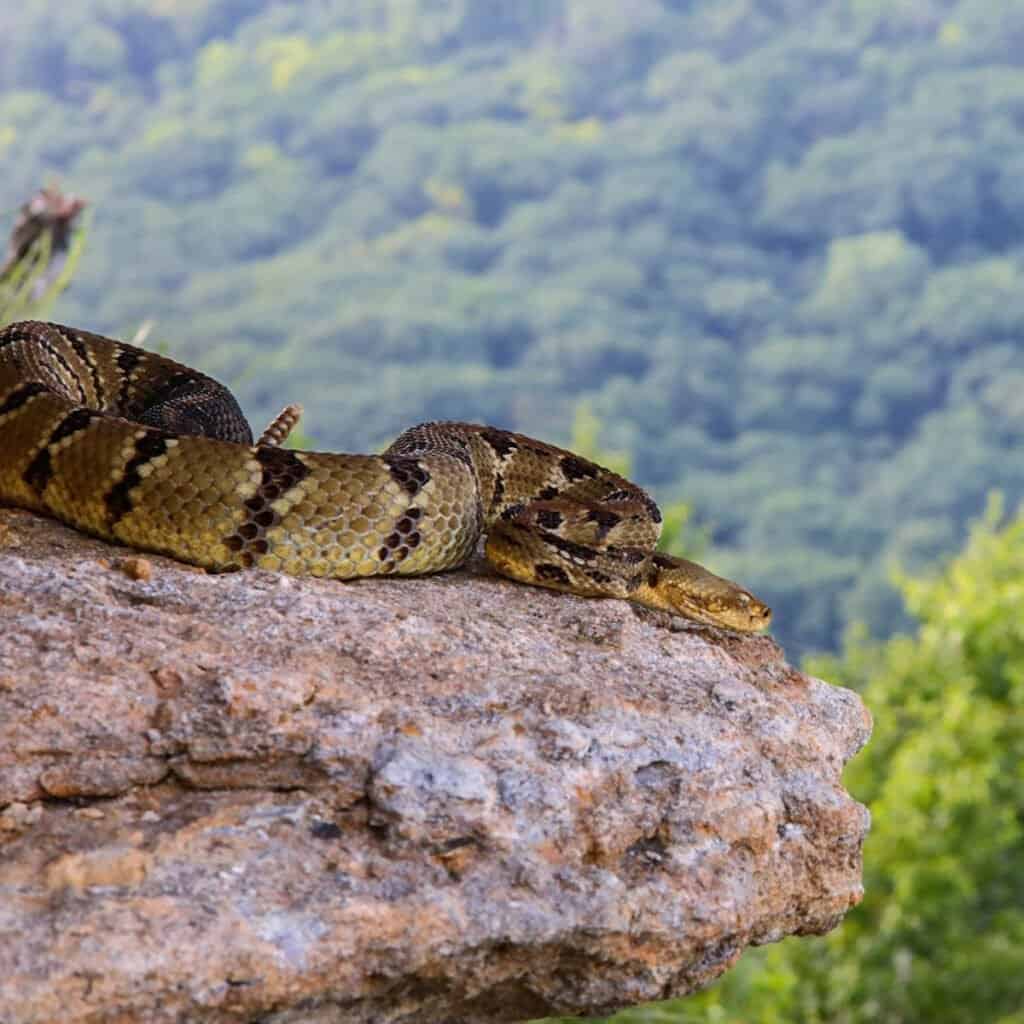
bradenjalexander/Shutterstock.com
Timber rattlesnakes are the largest venomous snakes in Missouri at nearly six feet long. Their natural habitat is rocky or wooded areas so you may come across one if you are hiking in the woods or hunting. Most Timbers snakes are brown or gray with a tan stripe running down the length of their bodies and sometimes gray or black markings as well. They generally don’t attack humans but if you hear a rattle or see a flash of orange the smartest thing to do is back up and choose a different way forward.
Western Pygmy Rattlesnake
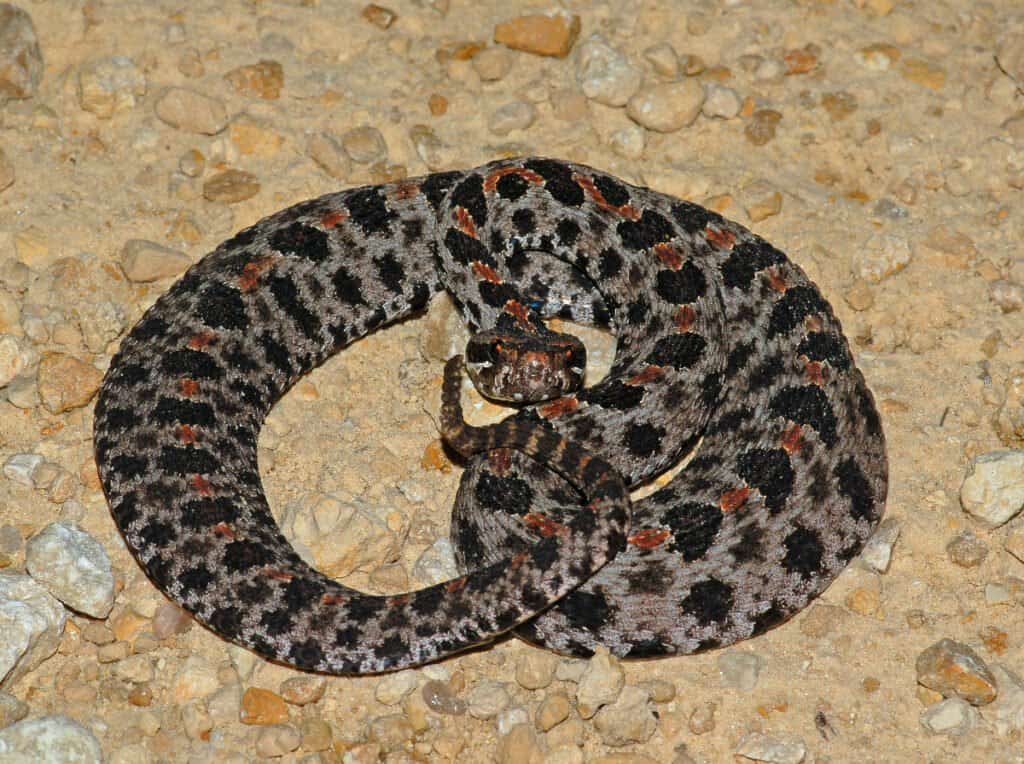
Gerald A. DeBoer/Shutterstock.com
Western pygmy rattlesnakes are the smallest type of rattlesnake and usually are less than two feet long. Like all rattlesnakes, they have some potent venom and do give a rattle as a warning before they attack. However, you have a very low chance of ever encountering one because they like to burrow and hide under rocks and brushes. They try to avoid humans.
These snakes are only found in the Ozarks and are found in counties bordering Missouri, but avoid grasslands and counties bordering the Mississippi.
Eastern Massasauga Rattlesnake
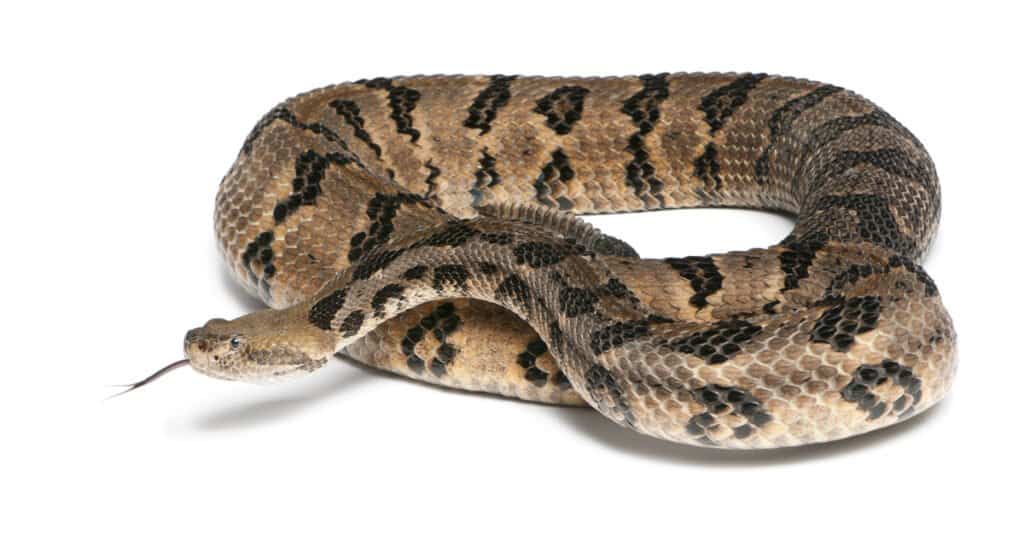
fivespots/Shutterstock.com
The massasauga rattlesnake is only found in the northern part of Missouri, and it’s very rare for any humans to come into contact with them. These snakes are gray with dark brown markings and they blend into their surroundings very well. Massasaugas have extremely potent venom, but if you are bit and get medical attention right away you should be fine. There’s only a handful of Massasauga bites in the entire country each year.
The Complete List of Snakes in Missouri
Missouri may be the “Show Me” state but you don’t really want to get face to face with the venomous snakes in Missouri. And even though most of the snakes that call Missouri home are non-threatening to humans, part of being safe around snakes is leaving them alone.
Yet, sometimes you can’t help engaging with snakes in the state if you almost step on one or cross a trail at the same time. So with that in mind, it’s important to be aware of snakes in the state and which ones may prove more dangerous.
A full list of all the types of snakes in Missouri includes:
- Western Worm Snake
- Northern Scarlet Snake
- Eastern Yellowbelly Racer
- Prairie Ring-necked Snake
- Great Plains Rat Snake
- Black Rat Snake
- Western Fox Snake
- Western Mud Snake
- Plains Hog-nosed Snake
- Eastern Hog-nosed Snake
- Prairie Kingsnake
- Speckled Kingsnake
- Red Milk Snake
- Eastern Coachwhip
- Mississippi Green Water Snake
- Yellow-bellied Water Snake
- Broad-banded Water Snake
- Diamond-backed Water Snake
- Northern Water Snake
- Rough Green Snake
- Smooth Green Snake
- Bullsnake
- Graham’s Crayfish Snake
- Ground Snake
- Midland Brown Snake
- Northern Red-bellied Snake
- Flat-headed Snake
- Western Ribbon Snake Thamnophis
- Plains Garter Snake
- Eastern Garter Snake
- Lined Snake
- Rough Earth Snake
- Western Earth Snake
- Eastern Copperhead
- Northern Cottonmouth
- Timber Rattlesnake
- Western Pygmy Rattlesnake
- Eastern Massasauga Rattlesnake
Discover the “Monster” Snake 5X Bigger than an Anaconda
Every day A-Z Animals sends out some of the most incredible facts in the world from our free newsletter. Want to discover the 10 most beautiful snakes in the world, a “snake island” where you’re never more than 3 feet from danger, or a “monster” snake 5X larger than an anaconda? Then sign up right now and you’ll start receiving our daily newsletter absolutely free.
More from A-Z Animals
.more-snake-card-image { max-height:140px !important; }
#mobileSnakeQuizControls { overflow: hidden; text-overflow: ellipsis; white-space: nowrap; }
@media (min-width: 481px) {
.mobile-top-content {
display: none;
}
}
#mobileTopContentCTACarouselControls { overflow: hidden; text-overflow: ellipsis; white-space: nowrap; }
.mobile-top-content .more { color: #fff; }
.mobile-top-content a { color: #fff; text-decoration: underline; }
.mobile-top-content a:hover { color: #fff; text-decoration: underline; }
@media (max-width: 480px) {
.mobile-top-content {
background-color: #06a10b;
color: #fff;
text-align: center;
/*height: 60px;
padding-top:5px;*/
font-size:80%;
/* display: block; */
margin: 0px -30px;
}
}
Missouri is known for having wide open plains, expansive waterways, and a large section of the Mississippi River. It also is home to almost 40 different species of snakes. That’s a lot of snakes, but only five of those snakes are venomous. The other types of snakes will usually not bother you as long as you don’t bother them. However, it’s never a good idea to taunt, harass, or try to handle a snake in the wild. Even non-venomous snakes can strike or bite if they are annoyed or if they feel threatened. Let’s dive into the snakes in Missouri so you can better understand the snakes of the “Show-Me” State.
Common Snakes In Missouri
The type of snakes that you run into in Missouri will depend largely on where in the state you are. There are distinct geographical areas of the state that each have different types of snakes. For example, snakes that live across almost the entire state of Missouri include the:
- Western Wormsnake
- Yellow-Bellied Racer
- Ring-Necked Snake
- Eatern Hognose Snake
- Prairie Kingsanke
- Speckled Kingsnake
- Milksnake
- Norther Water Snake
- Western Ratsnake
- Midland Brownsnake
- Ribbon Snake
- Eastern Gartersnake
- Smooth Earthsnake
- Copperhead (Venomous)
- Timer Rattlesnake (Venomous)
All other snakes in the state have more limited geographic presences that might not be in the Ozarks, long the Mississippi, or lacking from the prairies across the state. Now that we’ve established some of the most common snakes that range across almost all of Missouri, let’s dive into some nonvenomous snakes you’ll find in the state.
button.pulse {
transform: scale(1); animation: pulse 2s infinite;
box-shadow: 0 0 0 0 rgba(11, 247, 25, 1);
}
@keyframes pulse {
0% { transform: scale(0.90); box-shadow: 0 0 0 0 rgba(11, 247, 25, 0.5); }
60% { transform: scale(1); box-shadow: 0 0 0 15px rgba(11, 247, 25, 0); }
100% { transform: scale(0.90); box-shadow: 0 0 0 0 rgba(11, 247, 25, 0); }
}
Diamondback Water Snake

Laurie L. Snidow/Shutterstock.com
The diamondback water snake lives mostly near the rivers and lakes that dot the entire state of Missouri. If you fish or boat or spend a lot of time on the Mississippi River you will almost certainly see a diamondback water snake at some point. These snakes are not large, but the coloring patterns may mimic the color patterns of a venomous cottonmouth snake. Don’t approach a diamondback water snake unless you’re certain it’s not a cottonmouth. Diamondback water snakes don’t attack humans, but they may secrete a terrible odor trying to scare you away. They also might play dead if you startle them. Diamondback water snakes can grow up to four feet in length and aren’t found in the Ozarks.
Plains Garter Snake

Joe Farah/Shutterstock.com
The plains garter snake is a very colorful snake and you should be able to see it easily even in the tall grass. These snakes have a dull gray-green primary body color but they also have vivid stripes of yellow, or orange that run the entire length of their bodies. The natural habitat of the plains garter snake is prairies and meadows which means that Missouri is a perfect place for these snakes to live. If you are horseback riding, hiking, or biking across the prairies keep an eye out for a flash of yellow or orange as a Plains Garter snake goes by. The snakes are found most often in the northwestern corner of the state, but are also common in the greater St. Louis region.
Bull Snake

Markparker1983/Shutterstock.com
Bull snakes (gopher snakes) are some of the largest snakes in the entire U.S. and are often around six feet in length. They constrict their prey so they have wide heavy bodies that can crush mice, rats, and other rodents. They also eat birds, because bull snakes can slither their way up trees and into branches. Make sure that you keep an eye out for snakes above you in the trees when you’re enjoying outdoor activities in Missouri. Bull snakes are not venomous, but they are strong and powerful and have even been known to eat venomous rattlesnakes. It’s best if you don’t approach bull snakes even though they aren’t venomous. Bull snakes are common across Missouri grasslands ut are less common in the Ozarks and the southern portion of the state.
Eastern Coachwhip Snake

Jay Ondreicka/Shutterstock.com
Eastern coachwhip snakes can look very scary but they are actually non-venomous and won’t hurt you unless you are antagonizing it. They are usually black or very dark brown to blend in with their surroundings and they can be extremely long. They are also very fast. Most of the time by the time you realize that there’s a snake near you it’s gone if it’s an eastern coachwhip! Sometimes these snakes will vibrate their tails to make a sound that is similar to a rattle trying to scare away something that they think is a threat.
Coachwhips are found across most of the southern half of the state, but are absent from the southeastern portion of Missouri.
Western Mud Snake

Nathan A Shepard/Shutterstock.com
We just described how coachwhips are absent from the southeastern corner of Missouri, so let’s introduce a snake species that’s only found in the southeastern portion of the state.
Western mud snakes are nocturnal so most of the time you won’t see them. Because they prefer to be active after dark these snakes have evolved a pitch-black body color but they have a bright orange or red set of markings that you should be able to see even at night. If you’re hunting early in the morning, or setting off for a hike soon after sunrise you may see some western mud snakes that are getting ready to go underground for the rest of the day.
Venomous Snakes In Missouri
There are three types of rattlesnakes in Missouri, in addition to a couple other venomous snakes. Even though Missouri doesn’t have a lot of venomous snake breeds there are enough that anyone who is spending a lot of time outdoors should know how to identify these venomous snakes and always be careful whenever you come across snakes in the wild so that you can avoid a potentially very serious bite:
Eastern Copperhead

iStock.com/David Kenny
The eastern copperhead has slightly less potent venom than other snakes on this list so chances are pretty good that if you get bitten by a copperhead you won’t become dangerously sick. However, you still need to get medical attention right away if you are ever bitten by a copperhead. These snakes have a very distinctive copper tan color on their heads and pinkish-red coloring on their bellies. That should make it a little easier to identify them. They are relatively small and max out at about three feet long. The average length for a Copperhead is just over two feet.
The snakes are found across nearly all of Missouri with just a small part of the state being outside their range along the Iowa border.
Cottonmouth

KF2017/Shutterstock.com
A cottonmouth snake can have several different color variations that may be confusing because they make it look like other breeds of snakes. However, the cottonmouth has one distinctive feature that you will only ever see on a cottonmouth and that is a white mouth.
When the Cottonmouth raises its head you will see white around the mouth and there will be two black bars underneath its mouth. If it opens its mouth you will see that the inside of the mouth area is also white. But if a cottonmouth is opening its mouth at you then you need to take evasive maneuvers immediately. Move very slowly and carefully and back up step by step until you are out of the snake’s range. If you just wait quietly and stay still the snake will likely leave rather than attack you.
Cottonmouths are only found in the southeast and Ozark regions of Missouri. They prefer being close to aquatic environments, living in swamps and marshlands.
Timber Rattlesnake

bradenjalexander/Shutterstock.com
Timber rattlesnakes are the largest venomous snakes in Missouri at nearly six feet long. Their natural habitat is rocky or wooded areas so you may come across one if you are hiking in the woods or hunting. Most Timbers snakes are brown or gray with a tan stripe running down the length of their bodies and sometimes gray or black markings as well. They generally don’t attack humans but if you hear a rattle or see a flash of orange the smartest thing to do is back up and choose a different way forward.
Western Pygmy Rattlesnake

Gerald A. DeBoer/Shutterstock.com
Western pygmy rattlesnakes are the smallest type of rattlesnake and usually are less than two feet long. Like all rattlesnakes, they have some potent venom and do give a rattle as a warning before they attack. However, you have a very low chance of ever encountering one because they like to burrow and hide under rocks and brushes. They try to avoid humans.
These snakes are only found in the Ozarks and are found in counties bordering Missouri, but avoid grasslands and counties bordering the Mississippi.
Eastern Massasauga Rattlesnake

fivespots/Shutterstock.com
The massasauga rattlesnake is only found in the northern part of Missouri, and it’s very rare for any humans to come into contact with them. These snakes are gray with dark brown markings and they blend into their surroundings very well. Massasaugas have extremely potent venom, but if you are bit and get medical attention right away you should be fine. There’s only a handful of Massasauga bites in the entire country each year.
The Complete List of Snakes in Missouri
Missouri may be the “Show Me” state but you don’t really want to get face to face with the venomous snakes in Missouri. And even though most of the snakes that call Missouri home are non-threatening to humans, part of being safe around snakes is leaving them alone.
Yet, sometimes you can’t help engaging with snakes in the state if you almost step on one or cross a trail at the same time. So with that in mind, it’s important to be aware of snakes in the state and which ones may prove more dangerous.
A full list of all the types of snakes in Missouri includes:
- Western Worm Snake
- Northern Scarlet Snake
- Eastern Yellowbelly Racer
- Prairie Ring-necked Snake
- Great Plains Rat Snake
- Black Rat Snake
- Western Fox Snake
- Western Mud Snake
- Plains Hog-nosed Snake
- Eastern Hog-nosed Snake
- Prairie Kingsnake
- Speckled Kingsnake
- Red Milk Snake
- Eastern Coachwhip
- Mississippi Green Water Snake
- Yellow-bellied Water Snake
- Broad-banded Water Snake
- Diamond-backed Water Snake
- Northern Water Snake
- Rough Green Snake
- Smooth Green Snake
- Bullsnake
- Graham’s Crayfish Snake
- Ground Snake
- Midland Brown Snake
- Northern Red-bellied Snake
- Flat-headed Snake
- Western Ribbon Snake Thamnophis
- Plains Garter Snake
- Eastern Garter Snake
- Lined Snake
- Rough Earth Snake
- Western Earth Snake
- Eastern Copperhead
- Northern Cottonmouth
- Timber Rattlesnake
- Western Pygmy Rattlesnake
- Eastern Massasauga Rattlesnake
Discover the “Monster” Snake 5X Bigger than an Anaconda
Every day A-Z Animals sends out some of the most incredible facts in the world from our free newsletter. Want to discover the 10 most beautiful snakes in the world, a “snake island” where you’re never more than 3 feet from danger, or a “monster” snake 5X larger than an anaconda? Then sign up right now and you’ll start receiving our daily newsletter absolutely free.







